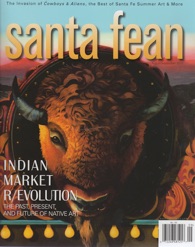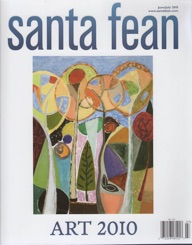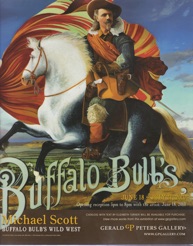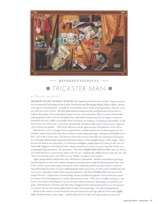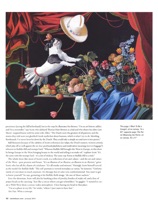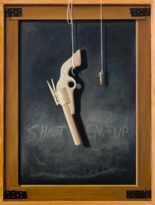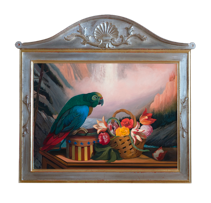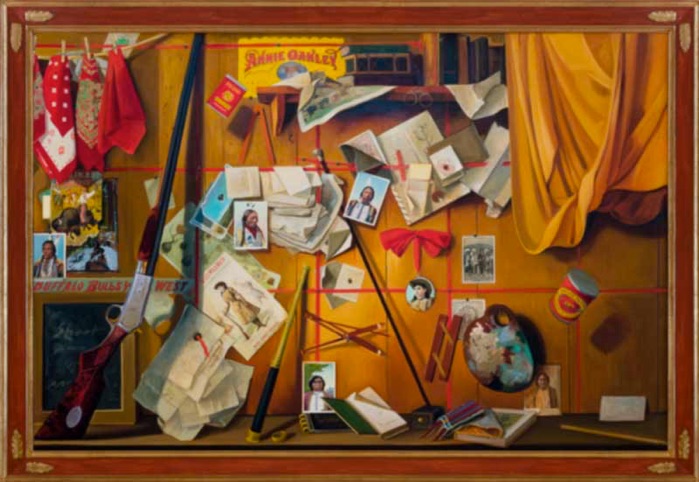The Santa Fean

Trickster Man
By Devon Jackson
Michael Scott wasn’t always the impish artist he has been of late. Long renowned for his masterful landscapes of the Pacific Northwest and Monhegan Island, Maine, about a dozen years ago he switched gears- actually, he switched his entire mode of transportation. First he came out with two series of oils- fanciful philosophical narratives that used barnyard fowl as foils to explore the nature of art, inspiration, beauty, success, and commerce. Then, in 2006, shortly after relocating from Ohio to his newly built home and studio outside Santa Fe, he began to immerse himself in the rich, risible, irresistible West: it’s history, it’s romance, it’s fantasies and realities. In all three shows, he referenced- pictorially, thematically, metaphorically, and in what is now a signature vivid Technicolor palette- Old Dutch Masters and the great trompe l’oeil painters of the 1800s.
Mischievous as he is, though, Scott’s impish bent in neither shtick nor newfound gimmick. Nor should it imply that just because there’s humor in them thar paintings- and puns and double entendres -his work is lesser than. The humor’s there but it never overrides his seriousness of purpose, his stunning craftsmanship and compositional acumen, or the outright beauty of his images. That’s because his humor isn’t just jokes, it’s informed, intelligent, sophisticated. It’s funny in the vein of Annie Hall, Magritte, and Daniel Defoe, a funny aimed not so much at uncovering the Truth as at posing (poking?) questions- The questions. “This show (Buffalo Bulb’s Wild West Show, June18-July 31 at Gerald Peters) is a conversation about who we are,” explains the affable Kansas-born 58-year old. “Not to be preachy but to ask, Who are we? What’s our place in the world?”
Again, purposefully modeled after the Old Masters’ portraiture, still- lifes, and tableaus paintings, and mixing that in with 19th-century western painting. Scott seems to have found the perfect narrative hook on which to hang all his Big Questions: by cross-pollinating the tulip mania craze of 17th-century Holland (a time of economic abundance followed by economic disaster) with that of Buffalo Bill Cody (icon of all things Western-hucksterism, showmanship, dreams and illusions galore). Scott synthesizes much of what he’s been building up to in much of his previous work. “This show is totally Americana,” says Scott, a 1976 alum of the Kansas City Art Institute whose stint at the Skowhegan art residency program with Rackstraw Downes and Alex Katz, changed his life and transformed his art. “Its operatic It’s theater. You see the curtain pulled back in many of the paintings.” Literally and figuratively.
Based on the country’s recent financial crisis and started two years ago (ahead of the crash), Buffalo Bulb is all about beauty, value, image- and the illusoriness of it all. Scott genius lies not only in his prescience (seeing the fall beforehand) but in the ways he illustrates his themes. “I’m an art history addict, and I’m a storyteller,” says Scott, who idolized Thomas Hart Benton as a kid and who shares his John Gaw Meem- inspired home with his artist wife, Ellen. “The Dutch were the greatest of all painters, and the stories they told were not glorified Greek myths but about humans, which is what I try to do. Memling, Rembrandt, I’ve never been let down by the Dutch. They could take a simple act and turn it into poetry”. Bulb blossoms become of the subtlety of Scott’s references (to tulips, the Dutch masters, western artist), which play off so well against the no-less-profound playfulness and multivalent meanings (or is it baggage?) inherent in Buffalo Bill and trompe l’oeil. “Whereas Buffalo Bill brought the West to Europe, in this show he brings Europe to the West, bringing beauty to the world and selling it as snake oil,” explains Scott. “It’s the same with the trompel’oeil--it’s trickery. The same way Ponzi or Buffalo Bill is a trick.”
The whole show, like most of Scott’s work, is a reflection of Art and values--and the art and values of the West--past, present, future. “It’s an illusion of an illusion, an illusion in and illusion,” grins Scott, who has all the charm of a trickster. “It’s all smoke an mirrors.” Fittingly, Scott himself served as the model for Buffalo Bulb. “The self-portrait is viewed nowadays as vanity,” he laments. “Unfortunately, it’s not done so much anymore. It’s therapy, but it’s also very confrontational. You want to get to know yourself’” he says, gesturing at his Buffalo Bulb image, “do one of those suckers.”
Ever the showman, Scott will also be hawking a line of jewelry, bottles of snake oil, and a line of prayer beads at the opening. “Just like a circus where you get tchotchkes,” he laugh’s. “I wanted to create a Wild West show, a circus-rodeo atmosphere. I love having my head in that place. “I’m at a phase in my life,” he winks, “where I just want to ha fun.” Art Fun. What a concept.
